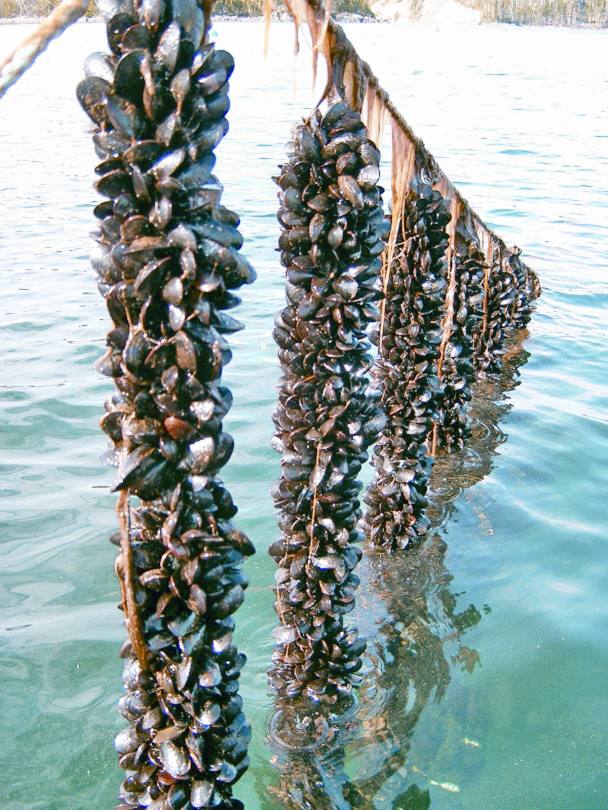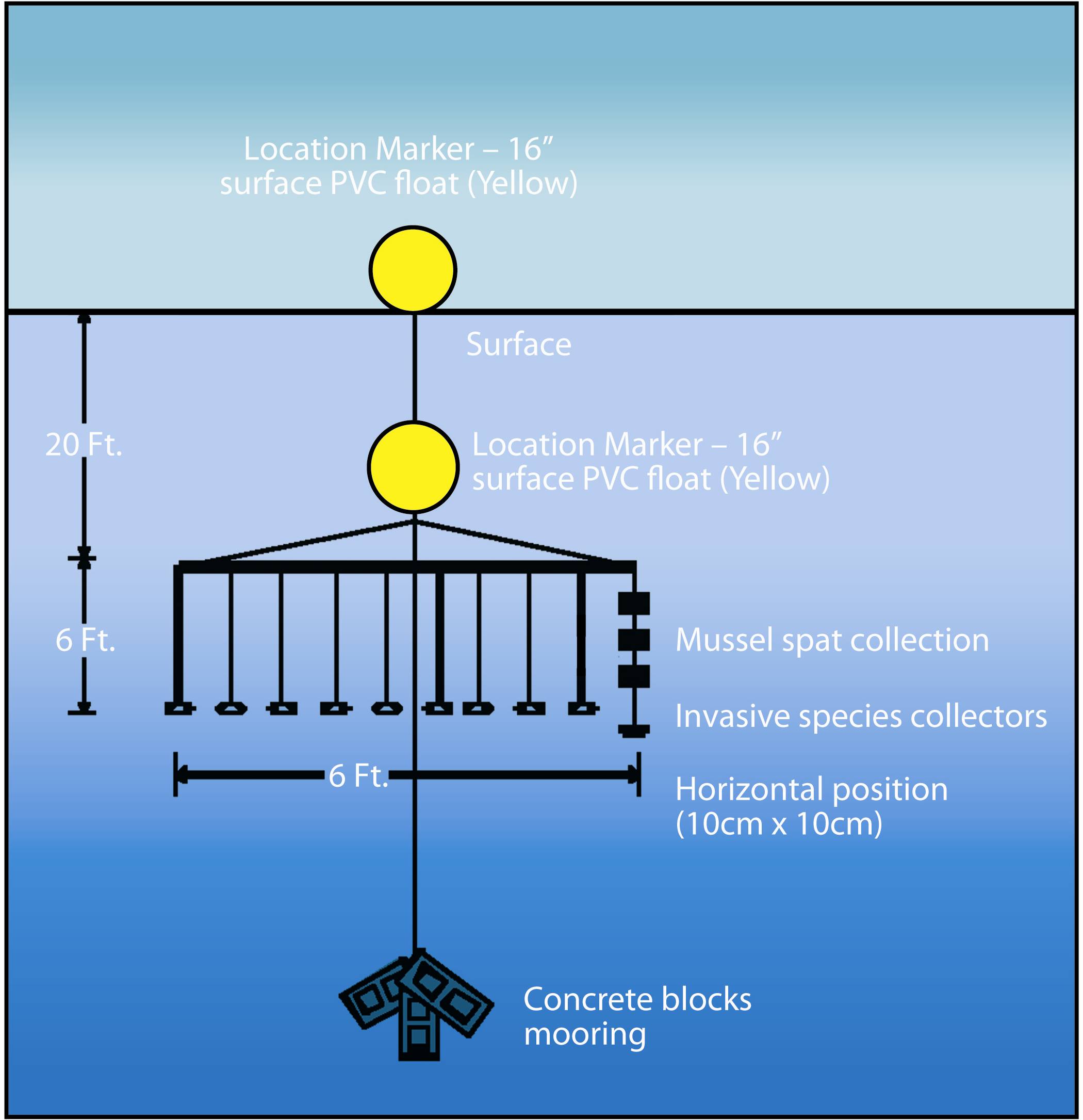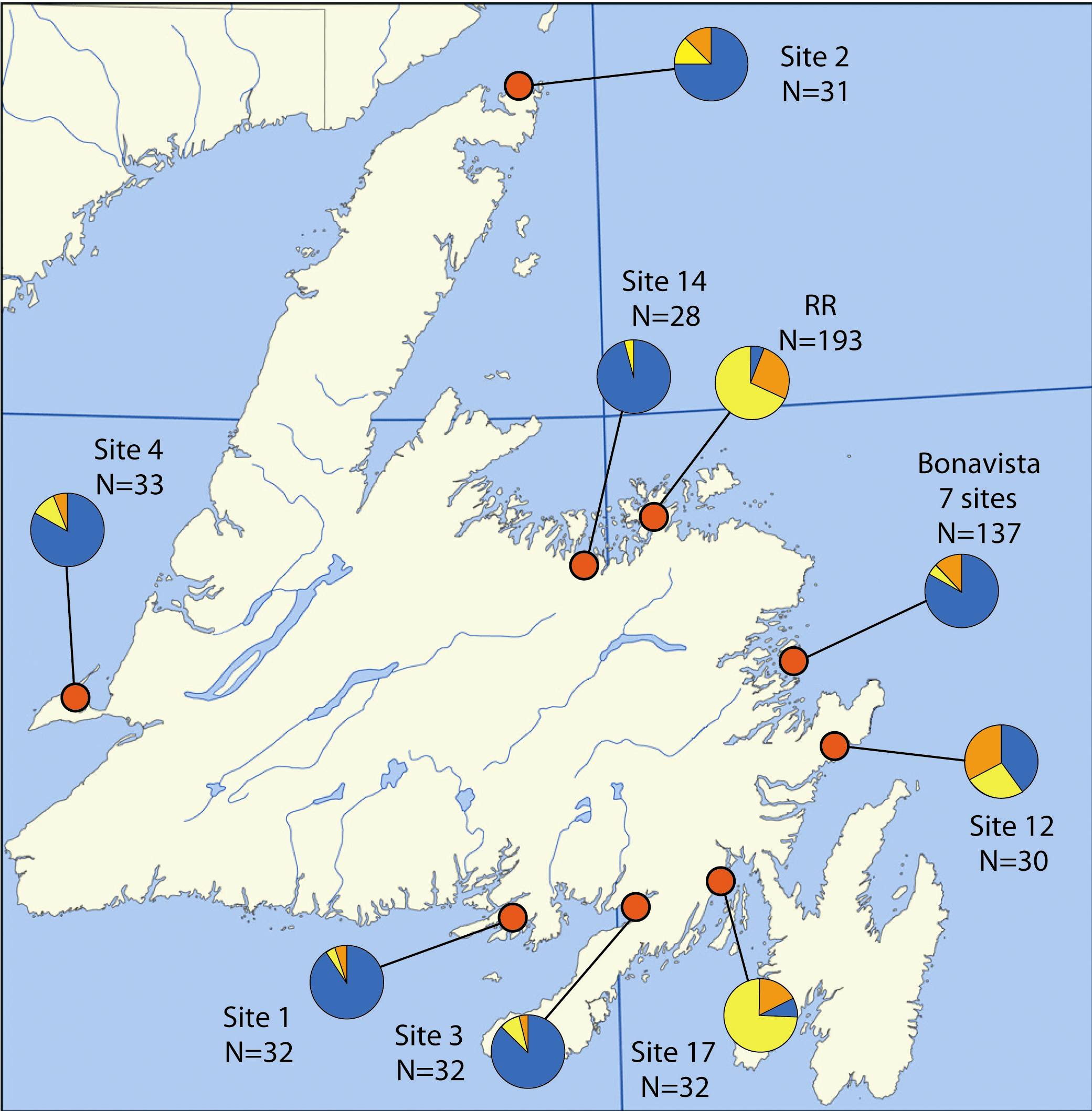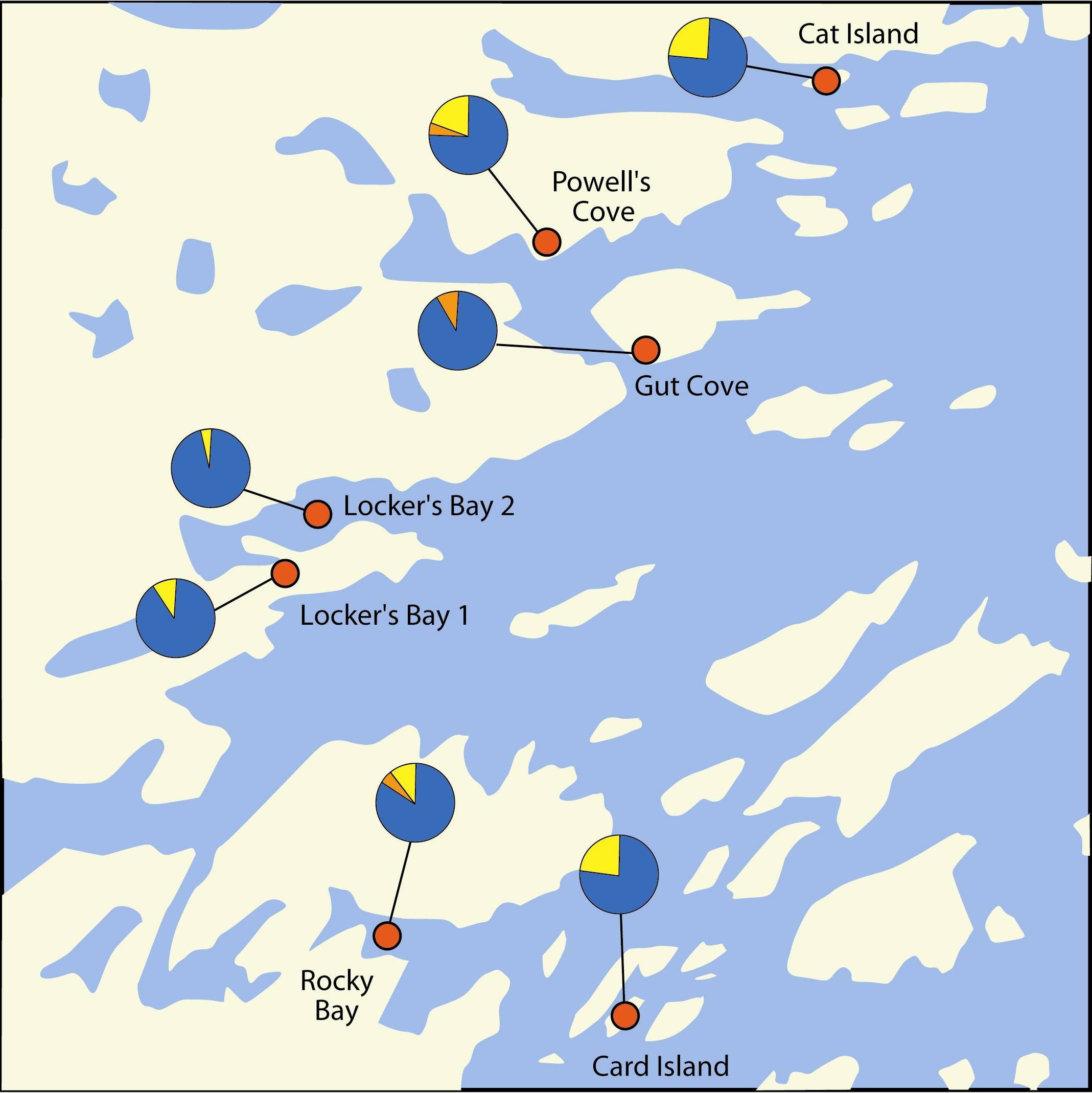Aquaculture Collaborative Research and Development Program (ACRDP) Fact Sheet
Issue 10 - May, 2012
Summary
The rapidly-growing mussel industry in Newfoundland requires new spat collection sites from areas close to their growout sites. This would provide backup for seed collection, allow for better growth performance as the young mussels become acclimated to the environmental conditions closer to the growout sites, and reduce seed transport costs. Species composition and potential sites for mussel culture were evaluated in a multi-year study. The objective was to identify several mussel seed collection sites in the Placentia and Bonavista Bay regions of Newfoundland. Following a 2-year time series experiment, it was determined that preferential seed collection of two blue mussel species commonly found in the coastal waters of Newfoundland, Mytilus edulis and Mytilus trossulus, was not significantly affected by the set depth or timing of collection (eastern Notre Dame Bay). However, for the Placentia Bay site, numbers of M. trossulus and hybrids of the two species increased over the summer. This suggested that to collect M. edulis, spat collections must be made earlier in the year. Seed transfer trials were initiated based on data obtained from this study. The results of this study contribute toward the process of locating alternate seed collection sites to foster sustainable development of the mussel aquaculture industry in Newfoundland.
Introduction

Mussel farming in Newfoundland has experienced rapid expansion in recent years. Mussel growers in Newfoundland identified the lack of good seed sites as a significant challenge to expansion of the industry. Growers wanted a good backup site in case the best current spat collection site - Woodfords Arm - became unavailable. Growers in the expanding industry on the south coast found that mussel seed brought in from Notre Dame Bay to the north was not growing very well in the new environment. Researchers thought that seed from the southern growout area might show greater growth. In addition, this would have the added benefit of reducing seed transport costs from more distant spat collection sites. Several growers also wanted their own seed collection sites that were close to their growout sites. This study examined the characteristics of a select group of possible sites as suggested by the mussel aquaculture industry.
There is a need to expand some of these collection sites and to find more conveniently-located seed collection sites. Newfoundland and Labrador lie in a hybrid zone where two mussel species (Mytilus edulis and Mytilus trossulus) and their hybrids co-exist. There is evidence that suggests that M. edulis grows more rapidly, has a thicker shell, exhibits higher survival rates, and has stronger byssal threads than M. trossulus. The two species may also show temporal (time) and spatial (depth) differences during the period when spat settles out. This would allow partitioning of seed collection on temporal and spatial scales, thereby maximizing seed collection and mussel performance, as M. edulis exhibits superior growth and hardiness against damage during growout and transport following harvest. Additionally, the prospect of modifying seed collection husbandry was examined to enhance the collection of the M. edulis spat in sites that had mixed species and hybrids.
This study evaluated existing and new seed collection sites and will investigate husbandry practices. Additionally, this study investigated whether the growth performance of M. edulis is superior to M. trossulus among sites due to different environmental and oceanographic conditions (e.g., ice-free state, cold vs. warm-water oceanic currents) that may be favourable for the growth of one species over another.

Figure 1
Sampling locations in bays along the coast of Newfoundland, Canada.Methods
Collection protocols were developed for the 2006 and 2007 seed collection in this study, based on a preliminary study conducted in 2005.
Eleven experimental collection sites were surveyed in Placentia Bay in 2006. The six most promising sites were re-evaluated for consistency in 2007. Ten experimental collection sites were surveyed in Bonavista Bay in 2007 (Figure 1) where a new "small footprint" seed collector, robustly designed to better withstand the effects of winter ice damage, was used for the seed collection (Figure 2).
Sixteen collection sites at eight existing mussel farms were sampled in Bonavista Bay and throughout the Island in 2006.

Figure 2
Experimental seed collector designed and used for the study. The invasive species collectors are settling plates for invasive tunicates.Invasive species collectors are part of the standard Fisheries and Oceans Canada's Aquatic Invasive Species (AIS) Atlantic Zone Monitoring protocol for monitoring invasive tunicates. These were added to the mussel spat collectors to ensure that new mussel seed sites would not have an AIS. The presence of invasive species would make seed harvest difficult and could also result in the transfer of invasive species between collection and growout sites. Mussels species were identified using diagnostic genetic markers (Glu, ITS) to differentiate the species and identifiy hybrids of M. edulis, and M. trossulus.
In addition, in 2006 and 2007, two commercial mussel sites, one in Placentia Bay (Site 17, Figure 3) and one in Notre Dame Bay (Reach Run) were sampled over a time and depth series experiment. Between May and October, samples were taken every two weeks using three standard seed collecting ropes at three depths (top, mid, bottom). This time series experiment was extended in both areas over the winter with collectors remaining in the water.
Results
No invasive tunicate species were found on any of the collectors associated with the mussel spat collection.
There was a large variation in mussel spat collection among the eight mussel farms (Figure 3). Mussel seed collection at the Reach Run site (RR) in Notre Dame Bay and Site 17 in Placentia Bay was dominated by M. trossulus and hybrids (Figure 3). The remaining five sites were dominated by M. edulis.

Figure 3
Species composition of mussel spat sampled at mussel farms throughout Newfoundland. RR - Reach Run.Mytilus edulis,
Mytilus trossulus,
hybrid
In 2006-2007, M. trossulus accounted for more than 50% of the individuals collected in nearly all experimental sites in the Placentia Bay region (Figure 4), whereas M. edulis comprised more than 50% of collected seed at only two experimental sites (sites 5 & 7). Low numbers of seed were collected from Bonavista Bay in 2007. Although a higher percentage (>75%) of M. edulis was found at all sites (Figure 5).

Figure 4
Species composition at each of the Placentia Bay sampling sites (2006 [left], 2007 [right]).Mytilus edulis,
Mytilus trossulus,
hybrid

Figure 5
Species composition at each of the Bonavista Bay sampling sites 2007.
Mytilus edulis,Mytilus trossulus,
hybrid
At two commercial sites (Placentia Bay and Notre Dame Bay - Reach Run, the time and depth series experiment showed a species composition dominated by M. trossulus (69%), followed by hybrids (26%), and M. edulis (5%).
There was no segregation by depth for the Reach Run area. The over-winter time-series showed similar compositions (67% M. trossulus: 27% hybrids: 6% M. edulis), with no influence of depth. Interestingly, at the Placentia Bay site, the numbers of M. trossulus and hybrids increased over the summer, suggesting that M. edulis settles out of the water column earlier.

Conclusions
Based on mussel species composition data obtained from this study, several sites in Placentia Bay and Bonavista Bay have been selected for further examination and seed transfer trials.
During the two years of this study, preferential seed collection of the common blue mussel species, M. edulis and M. trossulus, was not significantly affected by the set depth or timing of collection at the Notre Dame Bay site. However, increasing proportions of M. trossulus and hybrids over the summer at the Placentia Bay site suggests an earlier setting of M. edulis. There was no discernable scientific explanation for the differences observed in relative frequencies of species and hybrids among sites. Identification of collection sites with an abundant and consistent supply of high quality mussel seed will contribute to sustainable development of the Newfoundland mussel industry.
This ACRDP project (N-05-01-04) was a collaborative effort among the Department of Fisheries and Oceans (DFO Science), the Newfoundland Aquaculture Industry Association, Memorial University of Newfoundland, the Fisheries and Marine Institute of Memorial University of Newfoundland, Provincial Department of Fisheries and Aquaculture, National Research Council - IRAP and the Canadian Centre for Fisheries Innovation. The lead scientist on this project, Dr. Cynthia McKenzie, can be contacted at Cynthia.McKenzie@dfo-mpo.gc.ca..
For further information on this and other ACRDP projects, visit: /aquaculture/acrdp-pcrda/index-eng.htm.
Published by:
Aquaculture Science Branch
Fisheries and Oceans Canada
Ottawa, Ontario K1A 0E6
©Her Majesty the Queen in Right of Canada 2012
ISSN 1919-6806 (Print)
ISSN 1919-6814 (Online)
ISBN: 978-1-100-20662-2
DFO/2012-1826
Cat. No.: Fs23-580/4-2012E-PDF
French version and alternative formats available through: /aquaculture/acrdp-pcrda/index-fra.htm.
- Date modified: